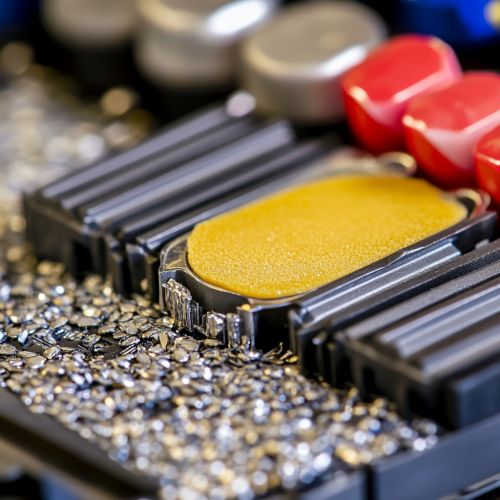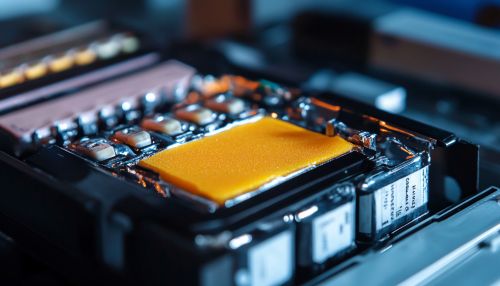Dry cell batteries
Introduction
A dry cell battery, also known as a dry cell, is a type of electrochemical cell that generates electrical energy from chemical reactions. Unlike wet cells, dry cells contain a low-moisture electrolyte paste, which makes them more suitable for portable electronic devices. Dry cells are commonly used in flashlights, remote controls, and various other consumer electronics.
History
The development of dry cell batteries can be traced back to the late 19th century. The first commercially viable dry cell was invented by Carl Gassner in 1886. Gassner's design was an improvement over the Leclanché cell, which used a liquid electrolyte. The dry cell's solid electrolyte made it more practical for everyday use, leading to widespread adoption.
Components
Dry cell batteries consist of several key components:
Anode
The anode in a dry cell is typically made of zinc. The zinc serves as the negative electrode and undergoes oxidation during the electrochemical reaction.
Cathode
The cathode is usually composed of manganese dioxide. This material acts as the positive electrode and undergoes reduction during the reaction.
Electrolyte
The electrolyte in a dry cell is a paste, often made from ammonium chloride or zinc chloride. This paste facilitates the flow of ions between the anode and cathode.
Separator
A separator is used to prevent the anode and cathode from coming into direct contact, which would cause a short circuit. The separator is usually made of a porous material that allows ions to pass through.


Types of Dry Cells
There are several types of dry cell batteries, each designed for specific applications:
Zinc-Carbon Batteries
Zinc-carbon batteries are the most common type of dry cell. They are inexpensive and widely used in low-drain devices like remote controls and clocks.
Alkaline Batteries
Alkaline batteries use potassium hydroxide as the electrolyte. They offer higher energy density and longer shelf life compared to zinc-carbon batteries, making them suitable for high-drain devices like digital cameras and portable radios.
Silver-Oxide Batteries
Silver-oxide batteries are known for their high energy density and stable voltage output. They are commonly used in watches, hearing aids, and other small electronic devices.
Lithium Batteries
Lithium dry cells use lithium as the anode material. They offer high energy density and long shelf life, making them ideal for high-performance applications like medical devices and military equipment.
Electrochemical Reactions
The electrochemical reactions in a dry cell involve the transfer of electrons from the anode to the cathode through an external circuit. The specific reactions depend on the type of dry cell:
Zinc-Carbon Reaction
In a zinc-carbon battery, the anode reaction is: \[ \text{Zn} \rightarrow \text{Zn}^{2+} + 2\text{e}^- \] The cathode reaction is: \[ 2\text{MnO}_2 + 2\text{NH}_4^+ + 2\text{e}^- \rightarrow \text{Mn}_2\text{O}_3 + 2\text{NH}_3 + \text{H}_2\text{O} \]
Alkaline Reaction
In an alkaline battery, the anode reaction is: \[ \text{Zn} + 2\text{OH}^- \rightarrow \text{ZnO} + \text{H}_2\text{O} + 2\text{e}^- \] The cathode reaction is: \[ 2\text{MnO}_2 + 2\text{H}_2\text{O} + 2\text{e}^- \rightarrow 2\text{MnOOH} + 2\text{OH}^- \]
Advantages and Disadvantages
Dry cell batteries offer several advantages and disadvantages:
Advantages
- **Portability**: The solid electrolyte allows for compact and portable designs.
- **Safety**: Reduced risk of leakage compared to wet cells.
- **Versatility**: Suitable for a wide range of applications.
Disadvantages
- **Limited Capacity**: Generally lower energy density compared to some other battery types.
- **Environmental Impact**: Disposal of dry cells can pose environmental hazards due to the presence of heavy metals.
Applications
Dry cell batteries are used in a variety of applications, including:
- **Consumer Electronics**: Remote controls, flashlights, and portable radios.
- **Medical Devices**: Hearing aids and glucose meters.
- **Military Equipment**: Portable communication devices and night-vision goggles.
Future Developments
Research in dry cell technology is ongoing, with a focus on improving energy density, reducing environmental impact, and enhancing safety. Advances in materials science and nanotechnology hold promise for the next generation of dry cell batteries.
